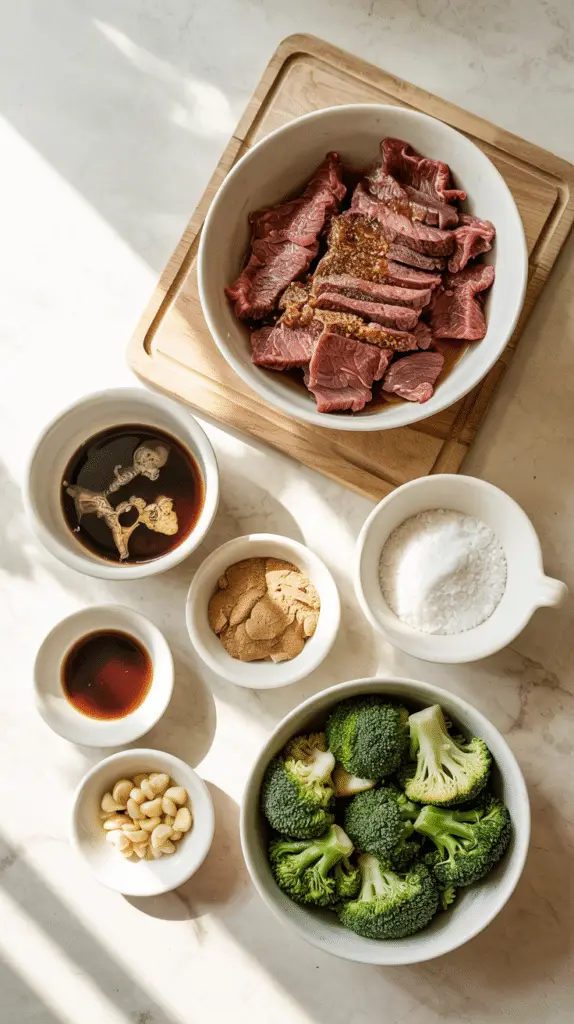Introduction & Inspiration
Chinese Beef and Broccoli is one of those takeout classics that I absolutely adore – tender slices of beef, vibrant green broccoli florets, all coated in a savory, glossy sauce. This recipe, promising to recreate that beloved dish at home with authentic flavors and techniques, immediately grabbed my attention! It seemed like the perfect way to enjoy a restaurant favorite with fresher ingredients and potentially a healthier profile.
My inspiration came from wanting to master the secrets behind truly tender stir-fried beef and perfectly crisp-tender broccoli, components that often make or break this dish. I was intrigued by the marinade ingredients (like cornstarch and optional baking soda) and the specific sauce components (like Shaoxing wine and dark soy sauce).
My goal was to explore this recipe and share how easy it can be to achieve results that are even better than takeout, right in your own kitchen. This recipe, with its clear instructions for marinating, blanching, and stir-frying, seemed like the perfect guide to making amazing homemade Beef and Broccoli.
Get ready to ditch the takeout menu for good!
Nostalgic Appeal
Beef and Broccoli is a cornerstone of American Chinese cuisine and holds significant nostalgic appeal for many. It evokes memories of family dinners at local Chinese restaurants, comforting takeout meals after a long week, and the satisfying combination of savory beef, crisp broccoli, and flavorful sauce served over rice.
The specific aroma of garlic, ginger, and soy sauce hitting a hot wok or skillet is instantly recognizable and appetite-inducing, transporting many of us back to those enjoyable dining experiences.
Even though it might not be a strictly traditional dish found in all regions of China, it has become a beloved and familiar classic in Western adaptations of Chinese food, solidifying its place as a nostalgic comfort food favorite.
Making this dish at home allows you to recreate those familiar flavors while controlling the ingredients and potentially making it even more delicious than you remember.
Homemade Focus (Restaurant Techniques at Home)
This Chinese Beef and Broccoli recipe is a fantastic example of how applying a few key techniques, often used in restaurants, can elevate your homemade cooking. While the process is relatively quick, steps like properly slicing the beef, marinating it (velveting), blanching the broccoli, and making the sauce from scratch are what make the difference.
I love that this recipe incorporates elements of “velveting” the beef – using cornstarch (and optionally baking soda) in the marinade. This technique helps to tenderize the meat and creates a silky coating that protects it during the high heat of stir-frying, resulting in incredibly tender beef slices, just like in good restaurants.
Blanching or steaming the broccoli briefly before adding it to the final stir-fry is another smart homemade step. This ensures the broccoli is perfectly crisp-tender and vibrant green, rather than becoming soggy or overcooked during the main stir-fry process.
By making the sauce yourself using components like Shaoxing wine and dark soy sauce, you achieve a depth and authenticity of flavor that pre-made sauces often lack. It highlights the rewarding results of focusing on technique and quality ingredients in homemade cooking.
Flavor Goal
The primary flavor goal of this Chinese Beef and Broccoli is a harmonious balance of savory, slightly sweet, and umami-rich flavors, coating incredibly tender beef and perfectly crisp-tender broccoli florets. It aims for that classic, satisfying taste profile beloved in American Chinese cuisine.
The marinated beef provides the savory, meaty foundation. The velveting technique ensures it’s exceptionally tender.
The broccoli offers a fresh, slightly earthy flavor and a crucial textural contrast – crisp yet tender. Blanching helps maintain its vibrant color and texture.
The sauce, a blend of chicken or beef stock, Shaoxing wine, soy sauce, dark soy sauce, and sugar, creates the signature savory, slightly sweet, and glossy coating. Shaoxing wine adds depth, while dark soy sauce contributes color and a hint of molasses flavor.
The aromatics – garlic and ginger – provide a pungent, fragrant base that infuses the oil and the entire dish with flavor. The cornstarch in the sauce thickens it perfectly to cling to the beef and broccoli.
Ingredient Insights
Let’s delve into the key ingredients:
Meat and Marinade:
- Boneless flank steak, skirt steak, or other cut: Thinly slicing against the grain is crucial for tenderness. Flank and skirt steak are common choices.
- Soy sauce: Adds saltiness and umami to the marinade.
- Peanut oil (or vegetable oil): Adds moisture and helps coat the beef.
- Cornstarch: Key velveting ingredient; creates a protective coating for tender beef.
- Baking soda (Optional): A restaurant technique! Helps tenderize tougher cuts of beef significantly by raising the pH. Use sparingly.
Sauce:
- Chicken stock (or beef stock): Provides the savory liquid base.
- Shaoxing wine (or dry sherry): A Chinese rice wine that adds depth and authentic flavor. Dry sherry is the best substitute.
- Soy sauce: Primary salty/umami flavor.
- Dark soy sauce: Adds color and a slightly sweeter, less salty flavor than regular soy sauce. Optional but recommended for appearance and depth.
- Brown sugar (or white sugar): Balances the savory notes.
- Cornstarch: Thickens the sauce.
Stir-fry:
- Broccoli: The key vegetable.
- Peanut oil (or vegetable oil): For stir-frying. Peanut oil has a high smoke point, ideal for stir-frying.
- Garlic cloves, minced & Ginger, minced: Essential aromatics.
Understanding these components helps achieve authentic flavor.
Essential Equipment
The most important tool for stir-frying is a good pan:
- A large nonstick skillet or wok: Essential for high-heat stir-frying and having enough room to toss ingredients. A wok is ideal for heat distribution, but a large, heavy-bottomed skillet works well.
- Sharp knife & Cutting board: For thinly slicing the beef against the grain and prepping vegetables.
- Small bowl: For the marinade.
- Medium-sized bowl: For mixing the sauce ingredients.
- Plate: To hold the blanched broccoli and cooked beef temporarily.
- Tongs (optional but helpful): For handling broccoli in the pan and wiping the pan.
- Measuring cups and spoons.
A large, hot pan is key to a successful stir-fry.
List of Ingredients with Measurements
Here’s the complete list of ingredients, with precise measurements:
Meat and Marinade:
- 1 lb boneless flank steak, skirt steak, or other cut (see footnote 1)
- 1 tablespoon soy sauce
- 1 tablespoon peanut oil (or vegetable oil)
- 1 tablespoon cornstarch
- 1/2 teaspoon baking soda (Optional) (see footnote 1)
Sauce:
- 1/2 cup chicken stock (or beef stock)
- 2 tablespoons Shaoxing wine (or dry sherry)
- 2 tablespoons soy sauce
- 1 teaspoon dark soy sauce (footnote 2)
- 2 teaspoons brown sugar (or white sugar)
- 1 tablespoon cornstarch
Stir-fry:
- 1 head broccoli, cut to bite-size florets
- 1 tablespoon peanut oil (or vegetable oil) (Footnote 3)
- 3 garlic cloves, minced
- 2 teaspoons ginger, minced
(Footnote clarifications based on typical usage: Footnote 1: Baking soda is for tenderizing tougher cuts; optional for flank/skirt. Cornstarch is for velveting texture. Footnote 2: Dark soy sauce is mainly for color and a hint of sweetness. Footnote 3: Use an oil with a high smoke point.)
Have all ingredients prepped and measured before starting the stir-fry (“mise en place”).

Step-by-Step Instructions (Elaborated)
Stir-frying moves fast! Let’s break it down:
1. Prepare the Beef:
- Slice the beef against the grain into thin (approx. 1/4 inch) slices or slightly thicker sticks. Transfer to a small bowl.
- Add soy sauce, peanut oil, cornstarch, and optional baking soda to the beef. Gently mix with your hands or chopsticks until all slices are evenly coated. Let marinate for at least 10 minutes while you prepare everything else.
2. Prepare the Sauce:
- In a medium-sized bowl, combine all the sauce ingredients: chicken/beef stock, Shaoxing wine/sherry, soy sauce, dark soy sauce, brown/white sugar, and cornstarch. Whisk well until the cornstarch is fully dissolved. Set aside.
3. Blanch/Steam the Broccoli:
- Add 1/4 cup of water to a large nonstick skillet or wok over medium-high heat. Bring the water to a boil.
- Add the bite-size broccoli florets and immediately cover the pan. Steam just until the broccoli turns bright green and becomes crisp-tender, about 1-2 minutes (recipe says 1 min). Do not overcook!
- Immediately transfer the broccoli to a plate. Carefully wipe out any remaining water from the hot pan using tongs and a paper towel.
4. Stir-Fry the Beef:
- Add 1 tablespoon of peanut oil (or other high-smoke point oil) to the now dry, hot skillet. Swirl to coat. Heat over medium-high heat until the oil shimmers.
- Carefully spread the marinated steak in a single layer in the hot pan. Do not overcrowd the pan; cook in batches if necessary.
- Allow the beef to cook undisturbed for about 30 seconds, until the bottom side is nicely browned.
- Flip the pieces and cook the other side briefly, just a few seconds. Continue to stir and cook until the surface is lightly charred but the inside is still slightly pink. Do not overcook the beef. Remove the beef to the plate with the broccoli.
5. Stir-Fry Aromatics:
- Add the minced garlic and ginger to the hot skillet (add a tiny bit more oil only if the pan is completely dry). Stir-fry constantly for about 30 seconds to 1 minute, until fragrant.
6. Combine and Finish:
- Return the cooked broccoli and beef to the skillet with the aromatics.
- Give the prepared sauce mixture a quick whisk again (cornstarch settles) and pour it into the skillet over the ingredients.
- Cook and stir constantly until the sauce bubbles and thickens, coating everything nicely, about 1 minute.
- Immediately transfer everything to a serving plate.
7. Serve: Serve hot as a main dish, typically with steamed rice.
Stir-frying requires having everything ready before you start cooking!

Troubleshooting
Stir-fries can be tricky if the heat or timing is off:
- Problem: Beef is tough.
- Solution: Slice thinly against the grain. Don’t skip the marinade (cornstarch velvets, baking soda tenderizes). Cook quickly over high heat in batches if needed; do not overcook.
- Problem: Broccoli is soggy or dull green.
- Solution: Blanch/steam the broccoli very briefly, just until crisp-tender and bright green. Don’t let it sit in the hot pan too long after steaming. Add it back only at the very end.
- Problem: Sauce is too thick or clumpy.
- Solution: Ensure cornstarch was fully dissolved in the cold sauce ingredients before adding to the hot pan. If it thickens too much, quickly stir in a tablespoon of water or broth.
- Problem: Sauce is too thin.
- Solution: Ensure the sauce came to a boil to activate the cornstarch. If still thin, you can make a small slurry (1 tsp cornstarch + 1 tbsp cold water), stir it in, and bring back to a simmer briefly.
- Problem: Dish is bland.
- Solution: Ensure proper amounts of soy sauce, garlic, and ginger. Taste the sauce before adding it and adjust salt/sugar if needed (though soy sauce adds significant salt). Use toasted sesame oil at the end if desired (not listed in this specific recipe, but common and adds flavor).
High heat and quick cooking are key!
Tips and Variations
Let’s customize this classic:
- Tip: Slicing partially frozen beef makes it much easier to get thin, even slices against the grain.
- Variation: Use different vegetables like sliced bell peppers, onions, snow peas, mushrooms, or water chestnuts along with or instead of some broccoli. Adjust blanching/stir-fry times accordingly.
- Tip: If you can’t find Shaoxing wine, dry sherry is the best substitute. Dry white wine or even chicken broth can work in a pinch, but the flavor will differ.
- Variation: Add a teaspoon of toasted sesame oil at the very end (off heat) for extra nutty aroma and flavor.
- Tip: Prep all your ingredients (slice beef, chop veggies, mince aromatics, mix sauce) before you start heating the skillet. Stir-frying moves fast!
- Variation: Make it spicy by adding red pepper flakes or a swirl of chili garlic sauce at the end.
Adapt it to your taste and what’s in your fridge!
Serving and Pairing Suggestions
Chinese Beef and Broccoli is a satisfying main course.
Serving: Serve immediately while hot and vegetables are crisp-tender.
Pairing:
- Steamed Rice: White or brown rice is the classic accompaniment to soak up the delicious sauce.
- Noodles: Serve over lo mein noodles, chow mein noodles, or even spaghetti for a different take.
- Other Dishes: Pair with other Chinese-American favorites like egg rolls, crab rangoon, or a simple wonton soup for a full meal experience.
It’s a complete meal when served with rice or noodles.
Nutritional Information
Nutritional information is approximate and depends on the cut of beef, oil used, and specific sauce ingredients. A typical serving (assuming 4 servings, without rice) might contain:
- Calories: 350-500
- Fat: 20-30 grams
- Saturated Fat: 5-10 grams
- Cholesterol: 60-100 mg
- Sodium: 800-1200+ mg (Soy sauce is high in sodium)
- Total Carbs.: 15-25 grams
- Dietary Fiber: 3-5 grams
- Sugars: 5-8 grams
- Protein: 25-35 grams
This dish provides a good amount of protein and vegetables. Sodium content can be high; use low-sodium soy sauce and broth to reduce it.
PrintChinese Beef and Broccoli
Make restaurant-style Chinese Beef and Broccoli at home! This recipe features tender marinated beef, crisp broccoli, and a savory sauce. Easy stir-fry!
Ingredients
Here’s the complete list of ingredients, with precise measurements:
Meat and Marinade:
- 1 lb boneless flank steak, skirt steak, or other cut (see footnote 1)
- 1 tablespoon soy sauce
- 1 tablespoon peanut oil (or vegetable oil)
- 1 tablespoon cornstarch
- 1/2 teaspoon baking soda (Optional) (see footnote 1)
Sauce:
- 1/2 cup chicken stock (or beef stock)
- 2 tablespoons Shaoxing wine (or dry sherry)
- 2 tablespoons soy sauce
- 1 teaspoon dark soy sauce (footnote 2)
- 2 teaspoons brown sugar (or white sugar)
- 1 tablespoon cornstarch
Stir-fry:
- 1 head broccoli, cut to bite-size florets
- 1 tablespoon peanut oil (or vegetable oil) (Footnote 3)
- 3 garlic cloves, minced
- 2 teaspoons ginger, minced
(Footnote clarifications based on typical usage: Footnote 1: Baking soda is for tenderizing tougher cuts; optional for flank/skirt. Cornstarch is for velveting texture. Footnote 2: Dark soy sauce is mainly for color and a hint of sweetness. Footnote 3: Use an oil with a high smoke point.)
Have all ingredients prepped and measured before starting the stir-fry (“mise en place”).
Instructions
Stir-frying moves fast! Let’s break it down:
1. Prepare the Beef:
- Slice the beef against the grain into thin (approx. 1/4 inch) slices or slightly thicker sticks. Transfer to a small bowl.
- Add soy sauce, peanut oil, cornstarch, and optional baking soda to the beef. Gently mix with your hands or chopsticks until all slices are evenly coated. Let marinate for at least 10 minutes while you prepare everything else.
2. Prepare the Sauce:
- In a medium-sized bowl, combine all the sauce ingredients: chicken/beef stock, Shaoxing wine/sherry, soy sauce, dark soy sauce, brown/white sugar, and cornstarch. Whisk well until the cornstarch is fully dissolved. Set aside.
3. Blanch/Steam the Broccoli:
- Add 1/4 cup of water to a large nonstick skillet or wok over medium-high heat. Bring the water to a boil.
- Add the bite-size broccoli florets and immediately cover the pan. Steam just until the broccoli turns bright green and becomes crisp-tender, about 1-2 minutes (recipe says 1 min). Do not overcook!
- Immediately transfer the broccoli to a plate. Carefully wipe out any remaining water from the hot pan using tongs and a paper towel.
4. Stir-Fry the Beef:
- Add 1 tablespoon of peanut oil (or other high-smoke point oil) to the now dry, hot skillet. Swirl to coat. Heat over medium-high heat until the oil shimmers.
- Carefully spread the marinated steak in a single layer in the hot pan. Do not overcrowd the pan; cook in batches if necessary.
- Allow the beef to cook undisturbed for about 30 seconds, until the bottom side is nicely browned.
- Flip the pieces and cook the other side briefly, just a few seconds. Continue to stir and cook until the surface is lightly charred but the inside is still slightly pink. Do not overcook the beef. Remove the beef to the plate with the broccoli.
5. Stir-Fry Aromatics:
- Add the minced garlic and ginger to the hot skillet (add a tiny bit more oil only if the pan is completely dry). Stir-fry constantly for about 30 seconds to 1 minute, until fragrant.
6. Combine and Finish:
- Return the cooked broccoli and beef to the skillet with the aromatics.
- Give the prepared sauce mixture a quick whisk again (cornstarch settles) and pour it into the skillet over the ingredients.
- Cook and stir constantly until the sauce bubbles and thickens, coating everything nicely, about 1 minute.
- Immediately transfer everything to a serving plate.
7. Serve: Serve hot as a main dish, typically with steamed rice.
Stir-frying requires having everything ready before you start cooking!
Recipe Summary and Q&A
Let’s conclude with a summary and FAQs:
Recipe Summary:
Chinese Beef and Broccoli is a classic stir-fry featuring thinly sliced, marinated beef (“velveted” for tenderness) and crisp-tender broccoli florets coated in a savory sauce made with stock, soy sauce, Shaoxing wine, and aromatics like garlic and ginger. It’s typically served over steamed rice.
Q&A:
Q: Can I make this ahead of time? A: Stir-fries are best served immediately for optimal texture. However, you can marinate the beef, chop the vegetables, and mix the sauce ingredients ahead of time. Store components separately in the fridge, then perform the quick stir-fry just before serving.
Q: How do I store leftovers? A: Store leftovers in an airtight container in the refrigerator for up to 3 days. Reheat gently 1 in a skillet or microwave (vegetables may soften upon reheating).
Q: Can I freeze this dish? A: Yes, you can freeze leftovers, but the broccoli’s texture may become softer upon thawing and reheating. Freeze in an airtight container for up to 2 months.
Q: What’s the best substitute for Shaoxing wine? A: Dry sherry is the closest substitute. You can also use dry white wine, Japanese sake, or even just chicken/beef broth if needed, though the flavor profile will change.
Q: Do I really need baking soda in the marinade? A: It’s optional but highly effective for tenderizing less tender cuts of beef. If using naturally tender cuts like flank or skirt steak sliced thinly against the grain, you might skip it, but the cornstarch is still important for texture.
I hope this detailed guide helps you create fantastic, restaurant-quality Chinese Beef and Broccoli at home! Enjoy the process and the delicious results!
Did Our Recipe Hit The Spot?
There are no reviews yet. Be the first one to write one.


